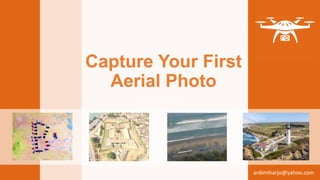
Capture Your First Aerial Photo
- 1. Capture Your First Aerial Photo by Ardimiharjo ardimiharjo@yahoo.com
- 2. 1. Choose Your Aerial Gears There are so many ways to take photo from above. The most common and practical ways to do it nowadays is using DRONE or Quadcopter. We recommend you to choose drones which has GPS features and also equipped with camera GIMBAL to ensure you have stabilized image
- 3. 2. Define Your Objects Is it scenery, area mapping, or maybe just peeping on neighbors ? We recommend you to choose drones which has GPS features and also equipped with camera GIMBAL to ensure you have stabilized image.
- 4. 3. Seize Your Location The landscape can look completely different depending on the season. Spring and autumn usually offer the most colorful pictures. They are the perfect time to capture fields in flower or orange-colored forests... Winter is interesting if you have the chance to fly around a mountainous area. However, any plain under snow can look even more flat and monotonous. It is also important to choose the right time of the day and, more specifically, to check the position of the sun in the sky. Because of the altitude, the risk of dazzle increases in late afternoon when the sun is low in the horizon. The sunset can offer spectacular views but with extreme contrasts between the sky and the land making it very difficult to capture. If you're flying when the sun is low, if possible choose the seat opposite to the sun.
- 5. 4. Is It Sunny Out There? Unless the pilot is a very good friend of yours, you probably won't have the opportunity to postpone the date of your flight and wait for the perfect weather. Do not be too disappointed if you are not flying in a perfect blue sky, you can always take advantage of a cloudy sky. Of course, sunny days provide in most cases the brightest pictures and accentuate the details of the ground. However, even when the weather on the ground is perfectly clear, you can encounter haze with altitude, significantly reducing your visibility and misting over your pictures. I find the best conditions come with a fairly cloudy day. Clouds have the advantage to naturally balance the light, and can also be a good shooting subject. Look out for funny shapes! An overcast sky inevitably reduces the light on the ground, tarnishing the pictures, but can also provide the right conditions for dramatic photos.
- 6. 5. An Angel’s Angle is… OBLIQUE - The most common type of aerial photograph. It is shot looking down at an angle to the ground HIGH OBLIQUES include the horizon LOW OBLIQUES doesn’t include the horizon (NEAR) VERTICAL - A photograph taken (almost) vertically above the subject, which are needed for scaling and mapping purposes or various occasion WIDE SHOT - A photograph taken usually to show the subject in context with its immediate surroundings PANORAMA - A loose term, usually referring to an exceptionally 'wide' shot, which includes a large area of the horizontal view
- 7. Check da List http://photo.net/learn/aerial/primer http://photography.tutsplus.com/tutorials/aerial-photography-tips-for-your-first-flying- experience--photo-5071 http://findaerialphotography.com/photograph_types.php https://www.pinterest.com/pin/87186942760483935/ Personal documentation of Branch Bengkulu
